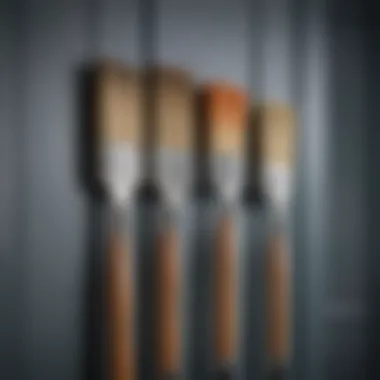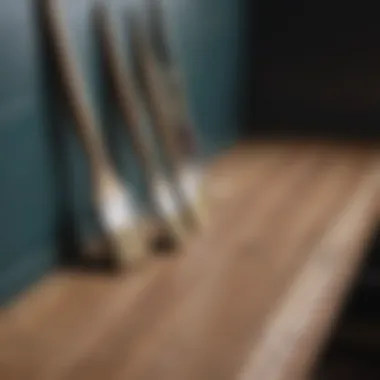Mastering Door Paint Brushes: Types, Tips & Techniques


Intro
Choosing the right door paint brush is crucial for achieving a flawless finish in any painting project. The type of brush influences not only the paint application but also the overall aesthetics and longevity of the work. With many options available, understanding the characteristics and applications of different brushes can significantly enhance the quality of your results.
This article delves into various aspects of door paint brushes, examining their types, applications, and the necessary care they require for continued effectiveness. By being informed about the correct choices, homeowners and design enthusiasts can elevate their interior spaces significantly.
Understanding Door Paint Brushes
In the realm of home improvement, understanding door paint brushes is essential for anyone looking to achieve a polished and professional look when painting their doors. Different brushes serve distinct purposes, and using the appropriate tool enhances the durability of the finish. A well-painted door not only adds aesthetic appeal but also protects the surface from damage. Recognizing the characteristics of door paint brushes allows homeowners to make informed decisions, ultimately improving the quality of their painting projects.
Definition of Door Paint Brushes
Door paint brushes are specialized brushes designed for painting door surfaces, whether interior or exterior. These brushes come in various shapes, sizes, and materials, each intended to deliver specific types of finishes. Generally, door paint brushes are built to hold and deliver paint evenly, minimizing brush strokes and achieving a smooth finish. The bristles on these brushes can be synthetic or natural, affecting how the paint adheres and how the brush performs.
Purpose and Importance
The primary purpose of door paint brushes is to facilitate an even and controlled application of paint. The right brush allows for precise edging, reducing the risk of paint on adjacent surfaces. This is particularly critical for doors, where detail and neatness are paramount. Additionally, using a brush suited for the type of paint can enhance the overall appearance of the door. For instance, oil-based paints may require different brushes than latex paints.
Furthermore, maintaining the integrity of the brush is crucial, as a poorly chosen brush can lead to uneven finishes, brush marks, and wasted paint. Homeowners, interior design enthusiasts, and anyone engaged in DIY projects stand to benefit significantly from understanding these brushes. They can achieve not just beauty in their application but also a sense of accomplishment in their painting efforts, significantly impacting the overall interior design of their home.
Types of Door Paint Brushes
Understanding various types of door paint brushes is essential for achieving the desired results in painting projects. Each brush type presents unique characteristics that can impact the finish, ease of use, and overall efficiency of the task at hand. By knowing the differences among these brushes, homeowners and interior design enthusiasts can select the most suitable tool for their specific needs. This knowledge leads to a more professional finish, saving time and paint in the process.
Synthetic Bristle Brushes
Synthetic bristle brushes are made from man-made materials like nylon or polyester. These brushes are ideal for use with latex paints, as they do not absorb water like natural fibers. This quality helps maintain the brush's shape and flexibility, allowing for smooth application.
Some key benefits include:
- Durability: Synthetic brushes can withstand a variety of paints and are less likely to wear out quickly.
- Easy Cleanup: Simply rinsing with water can clean these brushes, saving time and effort.
When choosing a synthetic brush, consider the size and the stiffness of the bristles. Stiffer bristles work well for flat surfaces, while softer ones cater better to detailed work. The finish achieved with synthetic brushes is typically smooth, making them a preferred choice for many.
Natural Bristle Brushes
Natural bristle brushes are crafted from animal hair, commonly hog, squirrel, or ox hair. These brushes are revered for their ability to hold and distribute paint effectively, particularly with oil-based paints. This characteristic enables a luxurious finish, ideal for more refined painting designs.
Advantages of using natural bristle brushes include:
- Excellent Paint Pickup: They can hold more paint, leading to fewer strokes needed for full coverage.
- Smooth Application: Natural bristles naturally soften the paint's texture, providing an elegant finish.
However, their maintenance requires more diligence. They often need to be cleaned with solvents rather than just water. For those opting for natural bristle brushes, it is essential to use them with compatible paints to prevent damage.
Foam Brushes


Foam brushes, often overlooked, offer a different texture and application method. These brushes are made of dense foam, making them suitable for smooth surfaces. They excel at applying materials like polyurethane and varnishes smoothly without leaving brush strokes.
The benefits of foam brushes are notable:
- Affordable: They are generally inexpensive and can be disposed of after use if desired.
- Minimal Cleanup: With foam, cleanup is effortless, as most paints can be wiped off quickly.
However, foam brushes can lack precision with detailed work compared to bristle brushes. They may not hold paint as well, but they are perfect for quick and easy tasks.
In summary, selecting the right type of door paint brush is crucial to achieving the best results in painting projects. Consider the materials, desired finish, and ease of use when making a choice.
Selecting the Right Brush
Selecting the right brush is vital for achieving a high-quality finish when painting doors. Choosing the appropriate brush can make the difference between a flawless look and a disappointing outcome. Understanding the specific elements involved in the selection process enhances the effectiveness of home improvement projects. Each painting task has its own requirements, and recognizing these needs is essential. This section breaks down critical considerations that homeowners should take into account.
Considerations for Brush Size
The size of the brush is one of the most important factors to consider. A larger brush can cover more surface area quickly, making it suitable for flat and wide door surfaces. However, smaller brushes are ideal for trim and detailed work, where precision is necessary. When assessing brush size, think about the door type. For instance, if dealing with a solid wood door, a 2.5-inch flat brush may work well. Conversely, if you are working on a paneled door, a smaller brush might be better to work around the panel edges.
- Standard Sizes: Brushes typically come in various sizes, ranging from 1 inch to 4 inches or more.
- Shape Matters: The shape of the brush, whether it's flat or angled, also plays a role in how effectively you can maneuver in tight spaces.
Once the size is identified, it can significantly aid in a smoother application and faster project completion.
Bristle Type Selection
Choosing the right bristle type is essential since it determines the brush's performance. Different bristle materials interact uniquely with various types of paint. Synthetic bristles, made from polyester or nylon, work well with water-based paints. They are durable and maintain their shape, allowing for smooth strokes. In contrast, natural bristle brushes, crafted from animal hair, excel with oil-based paints and varnishes. They absorb and release paint efficiently, which can lead to a more even application.
- Synthetic Bristles:
- Natural Bristles:
- Pros: Versatile, easy to clean, and long-lasting.
- Cons: May not perform as well with oil paints.
- Pros: Excellent for oil-based products and provide a smooth finish.
- Cons: Less durable with water-based paints and often require more care during cleaning.
Selecting the brush bristle type aligns your tools with the materials you are working with, guaranteeing improved outcomes.
Handle Length and Comfort
The length of the handle and its overall comfort directly affect how well you can control the brush during painting. A longer handle is suitable for reaching high areas, while a shorter handle allows for better precision and control in detailed work. It is essential to hold various brushes to find the one that feels best in your hand.
- Balance and Grip: Ensure that the handle provides a good grip and allows natural wrist movement.
- Weight Consideration: A lightweight brush may ease overall fatigue, especially during larger projects.
Finding a comfortable brush can lead to better painting technique and less strain on the body during extended use. Overall, considering handle length and comfort is crucial for a successful and enjoyable painting experience.
Techniques for Effective Painting
Understanding techniques for effective painting is essential for achieving a high-quality finish when working with door paint brushes. These techniques not only enhance the aesthetics of your painted doors but also contribute to the longevity of the paint job. Proper application methods minimize drips, ensure even coverage, and preserve brush integrity, making them indispensable for any homeowner or DIY enthusiast.


Prepping the Door Surface
Prepping the door surface is a critical step that should never be overlooked. Start with cleaning the door, removing dirt, grease, or old paint with a mixture of soap and water or a suitable cleaner. Sanding the surface is another necessary step. It creates a texture that allows the paint to adhere more effectively, reducing the chances of peeling later. Use fine-grit sandpaper for smooth surfaces. Finish this step by wiping down the door with a damp cloth to remove dust particles. Investing time in preparation leads to a more successful painting outcome.
Painting Methods
Cutting In
Cutting in refers to the technique of painting edges and corners with careful strokes, typically using a brush. This method is important for achieving clean, defined lines along the door's frames and any adjoining walls. One key characteristic of cutting in is its precision. A benefit of this technique is that it allows you to apply paint where a roller might not reach, especially in tight spaces. However, it requires practice to perfect the technique so that it does not create uneven edges.
Roller and Brush Combination
Using a roller and brush combination can be an efficient painting strategy. The benefit of this method is that the roller covers large flat areas quickly while the brush can handle intricate details and edges. This combination maximizes efficiency and effectiveness in the painting process, saving time while maintaining quality. A unique feature of this approach is the ability to achieve texture with the roller, which may enhance the visual depth of the paint. However, it may require additional cleanup due to using more tools.
Finishing Touches
Finishing touches are the final step in the painting process, ensuring that all areas are covered neatly and professionally. Inspect the painted door for any missed spots or drips. Touching up these areas with a small brush can make a significant difference in the overall appearance. Allow the paint to dry completely before reinstalling hardware to prevent smudging or marks. This careful attention to detail at the end of the process can elevate the look of your doors significantly, culminating in a successful painting project.
"Proper techniques not only enhance aesthetics but also protect your investment in home maintenance."
Taking the time to consider these techniques will lead to a more refined and durable paint job on your doors, reflecting both skill and care in your home projects.
Maintaining Your Brushes
Maintaining your brushes is critical to ensure that they perform well over time. A door paint brush is a significant investment in your painting arsenal. Proper care extends not only the life of the brush but also enhances the quality of your painting work. Many homeowners overlook this aspect, often leading to unsatisfactory results when repainting or touch-ups.
Cleaning Techniques
The way you clean your brushes affects their usability and longevity. Here are some methods to consider:
- Immediate Cleaning: After using a door paint brush, it is essential to clean it immediately. Paint, if left to dry, can harden bristles and ruin the brush.
- Water for Latex Paint: If you used latex paint, submerge the brush in warm, soapy water. Gently work the bristles with your fingers to remove paint. Ensure to flush out all paint remnants.
- Solvent for Oil-Based Paint: For oil-based paint, mineral spirits or paint thinner are appropriate choices. Dip the brush into the solvent and work it through the bristles. This process might require repeating several times, so patience is key.
- Final Rinse: Always end with a rinse in clean water or solvent, depending on the paint type used. This step removes any remaining cleaning agents, making the brush ready for the next job.
- Brushing Techniques: When cleaning, remember not to bend the bristles as it may alter their shape. Instead, gently reshape them once clean.
Storage Recommendations
Proper storage of your brushes is as important as cleaning them. Poor storage conditions can quickly degrade the quality of a brush. Consider these guidelines:
- Dry Completely: Always ensure your brushes are dry before storing. Moisture can lead to mold or damage the bristles.
- Stand Upright: Store brushes upright if possible. This method prevents bristle compression. If you can't, hang them with bristles facing down.
- Avoid Extreme Temperatures: Keep them in a climate-controlled space. Extreme heat or cold can warp the handles or bristles.
- Use Brush Holders: Invest in brush holders or sleeves. These are designed to protect the bristles from dust and damage while not in use.
"Proper maintenance and storage are vital steps for preserving your painting tools and ensuring optimal performance in your projects."
By following these techniques, homeowners and painting enthusiasts can maintain their door paint brushes in top condition. The effort put into maintaining your brushes directly influences the final finish of your painting endeavors. Taking care of these tools ensures that they remain effective, allowing for superior results in every project.
Environmental Considerations
In recent years, environmental awareness has gained prominence in various sectors, including home improvement and painting. It is essential for homeowners and design enthusiasts to consider the ecological impacts of their choices when it comes to door painting. The importance of environmental considerations lies not only in the materials used but also in the methods employed throughout the painting process. By adopting eco-friendly alternatives and sustainable practices, individuals can reduce harm to the planet while achieving elegant finishes in their homes.


Eco-Friendly Brush Options
When selecting door paint brushes, the options available on the market vary significantly in environmental impact. Eco-friendly brush choices offer benefits beyond just aesthetics. For instance, brushes made from synthetic fibers derived from recycled materials can minimize waste. Brands like Purdy and Wooster have begun to incorporate more sustainable elements into their brush designs. Also, natural bristle brushes from responsibly sourced animal hair are another option, as long as the sourcing adheres to ethical standards.
Using eco-friendly brushes ensures that harmful chemicals found in synthetic materials are reduced. These choices contribute to improved air quality, especially when painting indoors. Additionally, some brushes are designed to last longer, leading to less frequent replacements and reduced waste. Investing in quality, sustainable brushes ultimately allows for greater long-term savings for the consumer.
Sustainable Painting Practices
Beyond the brushes themselves, it is pertinent to adopt sustainable painting practices during any painting project. Here are some approaches that can make a difference:
- Choose Low-VOC or No-VOC Paints: Using paints with low volatile organic compound emissions limits harmful effects, enhancing indoor air quality. Brands such as Benjamin Moore and Sherwin-Williams offer environmentally friendly options that are also highly effective.
- Proper Cleanup: After completing a painting project, cleaning brushes with eco-safe solvents minimizes the environmental impact. Avoiding harsh chemicals is crucial for both personal safety and ecological friendliness.
- Donation of Leftover Paint: Instead of discarding excess paint, consider donating it to community programs or groups that can utilize it. This practice promotes resourcefulness and waste reduction, avoiding unnecessary landfill contributions.
By taking a thoughtful approach, homeowners can transform their painting tasks into responsible activities that contribute positively to the environment.
Incorporating these eco-friendly and sustainable options into your door painting process not only serves the environment but also enhances the overall quality of your living space. Engaging in mindful practices reflects a commitment to aesthetics without compromising ecological integrity.
Common Mistakes to Avoid
In the world of painting doors, several common mistakes can undermine the effort put into achieving a professional finish. Understanding these pitfalls is crucial for homeowners and design enthusiasts who want results that make an impact. Awareness of potential blunders helps in both project execution and tool longevity. Identifying these mistakes empowers users to execute their painting projects with greater precision and satisfaction.
Ignoring Brush Care
One significant error is neglecting the proper care of paint brushes. Brushes are essential tools in the painting process, and forgetting to clean them after use can lead to severe complications. When paint dries in the bristles, it hardens and can ruin the brush's shape and functionality. As a result, future projects may yield uneven or streaky finishes. Moreover, not maintaining brushes can lead to unnecessary expense; replacing them often proves costly. Regular cleaning, whether with water for latex paints or solvents for oil-based paints, is an investment in the tools that promote high-quality results.
To maintain brushes effectively, consider the following techniques:
- Rinse Immediately: Clean brushes soon after use to prevent paint from drying.
- Use Proper Cleaners: Depending on the paint type, use appropriate cleaning agents such as soap and water or mineral spirits.
- Shape the Bristles: After cleaning, reshape the bristles and store them flat or vertically to preserve their form.
Neglecting these practices can disrupt your painting workflow and lead to secondary problems down the road. In essence, brush care is an integral part of the entire painting process.
Using the Wrong Type of Brush
Another common error is using an inappropriate brush for a specific type of paint or surface. Brushes come in various forms, each intended for unique applications. Selecting the wrong one can dramatically affect the final outcome. For instance, using a synthetic bristle brush for oil-based paint may result in brush marks and uneven application. Alternatively, natural bristles might become limp when exposed to water-based products.
Before starting a project, it is crucial to evaluate:
- Bristle Material: Know when to use synthetic versus natural bristles based on the paint used.
- Brush Shape and Size: Use smaller brushes for detail work and broader ones for larger surfaces to ensure efficiency.
- Application Technique: Ensure that the brush fits the painting method, such as rolling versus cutting in, to achieve clean edges and smooth coats.
Ultimately, using the right brush not only enhances the aesthetics but it also streamlines the entire painting process. Avoiding these common mistakes will lead to a more satisfying painting experience.
Ending
In the realm of home improvement and preservation, understanding door paint brushes holds significant value. Selecting the appropriate brush not only affects the outcome of the painting task but also enhances the long-term durability of both the door and the brush itself. This article underlines essential elements concerning door paint brushes, emphasizing their function and importance in achieving a polished finish. When homeowners recognize these intricacies, they can undertake projects with improved confidence.
Summary of Key Points
- Types of Brushes: Knowing the different types of brushes, like synthetic and natural bristle brushes, is important for matching the brush to the paint type and the surface texture of the door.
- Selection Factors: Brush size, bristle type, and handle comfort are paramount when determining which brush to use for painting doors. These aspects influence ease of use and painting efficiency.
- Techniques: It is crucial to prep the door surface adequately and apply the right painting methods to ensure optimal results. Methods like cutting in or using a roller and brush combination can improve the application process.
- Maintenance: Regular cleaning and proper storage of brushes extend their life. Brush care should not be neglected, as it affects both performance and finish quality.
- Common Pitfalls: Avoiding mistakes such as ignorance of brush care and using the wrong type of brush can lead to subpar results and frustration during projects.
Encouragement to Experiment
Homeowners should feel motivated to explore varied techniques and brush types. Experimentation can lead to a more profound understanding of how different brushes interact with various paints. Trying out several approaches can help refine skills. Additionally, utilizing different brushes on diverse surfaces may produce surprising, aesthetically pleasing results.
Ultimately, the knowledge gained from this article serves as a foundation for enthusiastic painters. Trying new methods enhances satisfaction with painting tasks and nurtures creativity in home improvements. So pick a brush, choose a color, and embark on a painting journey!















